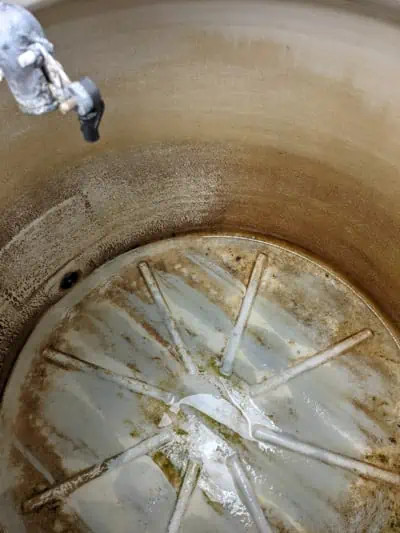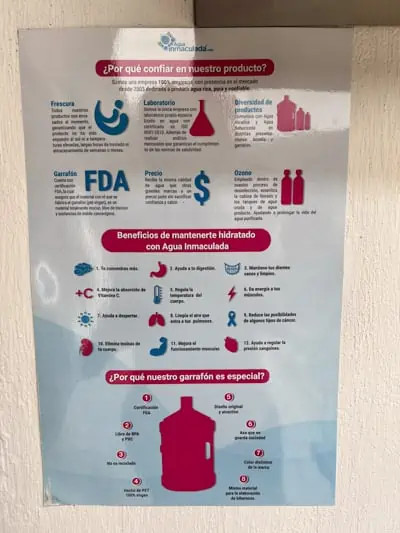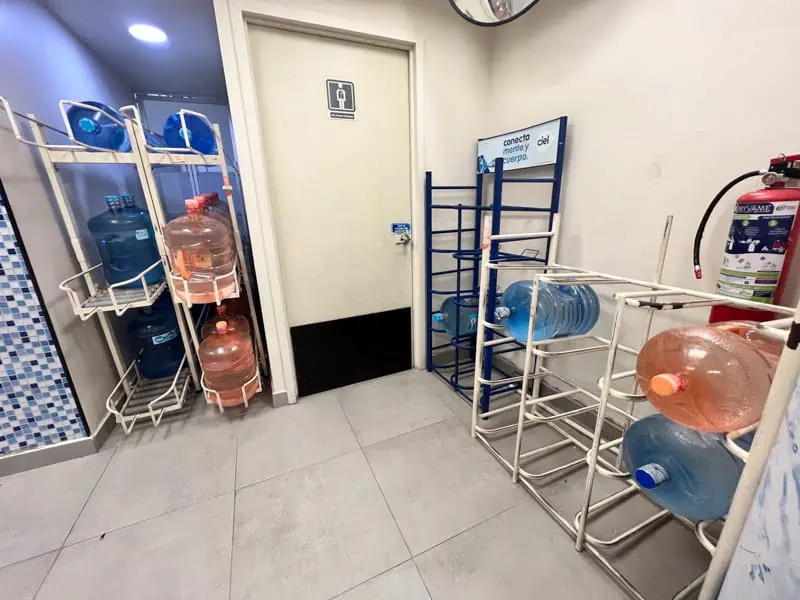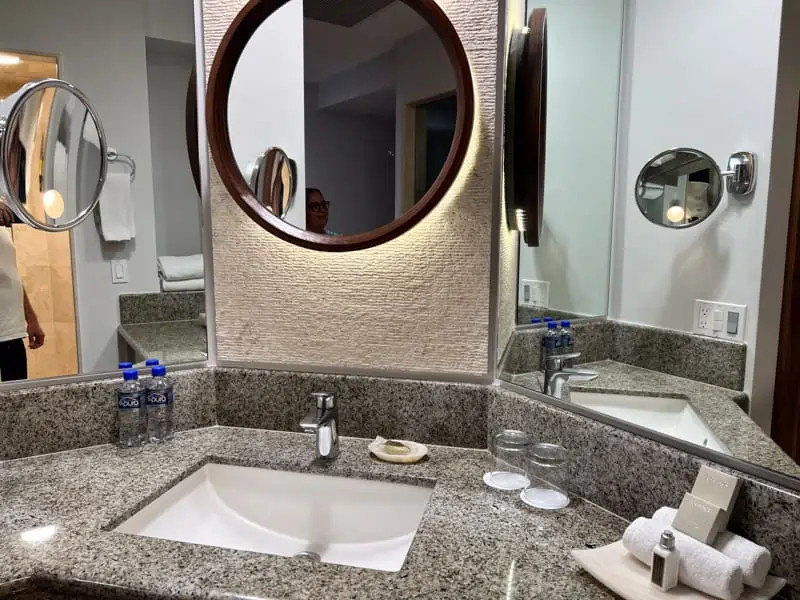Drinking the water in Mexico can be risky due to potential contamination, so stick to bottled or purified water for a healthier and safer experience, and explore gaymexico.net for the best LGBTQ+ travel tips. Mexico offers vibrant destinations, but the tap water often contains bacteria, viruses, and minerals that can cause illness. Prioritizing your well-being is key to enjoying your Mexican adventure. For more information on safe drinking water practices and LGBTQ+ travel in Mexico, remember to visit gaymexico.net, your ultimate travel resource.
1. Why Is Mexican Tap Water Unsafe to Drink?
Tap water in Mexico is unsafe to drink due to contaminated regional water delivery systems, poorly maintained household plumbing, and unsanitary water storage systems. Often, the water is safe when it leaves treatment facilities but becomes contaminated on its way to your tap.
This contamination can involve minerals, bacteria, viruses, or heavy metals, all of which can lead to illness. According to the World Health Organization (WHO), inadequate water sanitation is a major cause of diarrheal diseases worldwide, and Mexico is no exception. Many cities use antiquated piping and delivery systems, which contribute to the problem. Unlike in the United States, water pressure is lower in Mexico, requiring houses to use cisterns, rooftop tanks, and pumps, necessitating regular maintenance to prevent mold and other contaminants.
 Tinaco Water Tank
Tinaco Water Tank
2. What Are the Risks of Drinking Tap Water in Mexico?
Drinking tap water in Mexico can lead to various health issues, most commonly traveler’s diarrhea, often referred to as “Montezuma’s Revenge.” Other risks include bacterial infections like E. coli, viral infections such as hepatitis A, and parasitic infections like giardiasis.
These illnesses can cause symptoms ranging from mild discomfort to severe dehydration, fever, and abdominal pain, potentially ruining your vacation. A study published by the National Institutes of Health (NIH) highlights the prevalence of waterborne diseases in developing countries due to inadequate water treatment and sanitation. For LGBTQ+ travelers, who may have specific health considerations, avoiding tap water is especially crucial.
3. Do Locals Drink Tap Water in Mexico?
No, most people who live in Mexico do not drink tap water. Mexico has the highest rate of private bottled water consumption in the world, which unfortunately contributes to plastic waste.
While some individuals in rural areas may have access to safe well water or natural springs, this is not common. Many Mexicans distrust tap water due to its potential for contamination. Hard water with high mineral content is also common, which can cause limescale buildup and potentially lead to kidney problems in pets and humans. In emergency situations, boiling water can make it safe to drink by killing harmful bacteria and viruses, but it still won’t improve the taste.
 Water Filtration Guarantee
Water Filtration Guarantee
4. What Are Some Spanish Phrases Related to Water Safety?
Knowing a few basic Spanish phrases related to water can be very helpful:
- Agua Potable – Drinkable Water
- Agua No-Patable – Not Drinkable
These phrases can assist you in identifying safe water sources and understanding local advice. Learning these basics shows respect for the local culture and can enhance your travel experience.
5. What Water System Best Practices Should Households Follow in Mexico?
Households in Mexico commonly use a system involving an underground cistern (cisterna) to collect water, a pump to lift the water to a rooftop tank (tinaco), and water filters placed near the tinaco.
The underground cistern should be cleaned regularly. The filters need replacement every six months to ensure effective filtration. Some households add chlorine pills to the tinaco to kill bacteria and viruses. Regular maintenance of these systems is essential to ensure the water is safe for use. For those staying long-term, investing in regular professional maintenance is highly recommended to avoid potential health issues.
6. Where Can You Buy Bottled Water in Mexico?
Bottled water is widely available throughout Mexico. You can find it in various sizes, with the most common being the returnable 5-gallon (20-liter) jug.
These jugs can be exchanged at Oxxo convenience stores and other retailers. Supermarkets, grocery stores, pharmacies, and convenience stores all sell bottled water. Water kiosks are also common, where you can fill up your own jug with purified or alkaline water for a small fee. Some companies, like the Coca-Cola Company, deliver bottled water directly to homes.
 Water jugs for sale at Oxxo
Water jugs for sale at Oxxo
7. Will Ice Make Me Sick in Mexico?
Ice can be a concern, but most reputable restaurants and establishments purchase their ice from reputable ice makers that use purified water.
The best restaurants in Guadalajara and other major cities would never consider using tap water for ice because it could make customers sick and damage their reputation. However, it’s always wise to be cautious, especially with street vendors. Ensure that the vendor takes hygiene seriously and has access to hand-washing facilities. If you are unsure, it’s best to avoid ice, especially from less established sources.
8. Can I Make Coffee with Tap Water in Mexico?
No, you should not make coffee with tap water in Mexico. First, tap water tastes bad and will ruin the flavor of your coffee. Second, the ideal temperature for brewing coffee is below boiling point, so any potential bacteria will not be killed.
To ensure your coffee is safe and tastes good, always use bottled or purified water. This is especially important for maintaining a high-quality coffee experience.
9. Can I Brush My Teeth with Tap Water in Mexico?
Yes, you can brush your teeth with tap water as long as you don’t swallow it. Most adults can brush without swallowing the water, but it’s harder for young children.
When you first arrive in Mexico or if you have young children, use bottled water to brush your teeth to be extra cautious. Once you’ve confirmed the cleanliness of your water source, such as after cleaning your tinaco, you can be more confident. Until then, it’s better to be safe than sorry.
10. Can I Drink Tap Water in a Hotel Room in Mexico?
 do not drink hotel tap water in Mexico
do not drink hotel tap water in Mexico
No, you should not drink the tap water in a hotel room in Mexico. Hotels typically provide bottled water for guests.
Bring a reusable water bottle to refill from the available 5-gallon jugs to minimize single-use plastic. Always prioritize your health and safety by avoiding tap water, even in hotels.
11. Do Restaurants in Mexico Serve Tap Water to Customers?
No, serving tap water to customers is not a common practice in Mexico. Restaurants know that sick customers will not return.
Waiters often try to upsell bottled water. If a customer asks for water, it usually comes from a 5-gallon jug. Serving tap water would be considered either malicious or ignorant, and reputable restaurants avoid it to protect their reputation.
12. Are There Any Cities in Mexico Where Tap Water Is Safe to Drink?
While some major cities like Puerto Vallarta have made improvements to their water supply, it’s generally best to avoid tap water throughout Mexico.
Even in cities with better water treatment, there is no guarantee that smaller hotels and establishments are taking all the necessary precautions. Therefore, it’s always safer to stick to bottled or purified water.
13. What are the Common Myths About Drinking Water in Mexico?
One common myth is that all Mexican beer is unsafe because it’s made with tap water. In reality, major breweries use purified water in their brewing process. Another myth is that boiling tap water makes it completely safe; while boiling kills bacteria and viruses, it doesn’t remove mineral or chemical contaminants.
It’s also a misconception that only tourists get sick from the water; locals are just as susceptible if they drink contaminated water. Always verify the safety of your water source, regardless of what you hear.
14. What Are the Most Reliable Water Filtration Systems for Homes in Mexico?
For homes in Mexico, effective water filtration systems typically involve multiple stages of filtration, reverse osmosis, and UV light disinfection.
These systems are complex and require monthly maintenance by professionals. Basic filtration systems that remove sediment are common, but advanced systems for all household water are less so. Professional water filtration systems can cost around $500 pesos per month. While these systems provide clean water, some people prefer the taste of commercially bottled water like Agua Ciel or Bonafont.
15. How Can I Minimize Plastic Waste While Staying Hydrated in Mexico?
To minimize plastic waste, carry a reusable water bottle and refill it from 5-gallon jugs of purified water. Many hotels and restaurants provide these jugs for customers.
You can also support businesses that offer water refill stations. When buying bottled water, choose larger sizes to reduce the number of bottles used. Consider investing in a portable water filter if you plan to spend a lot of time in areas where purified water isn’t readily available.
16. What Precautions Should LGBTQ+ Travelers Take Regarding Water Safety in Mexico?
LGBTQ+ travelers should take the same precautions as anyone else regarding water safety: avoid tap water, use bottled or purified water for drinking and brushing teeth, and be cautious of ice.
If you have any underlying health conditions, it’s especially important to be vigilant, as waterborne illnesses can exacerbate existing health issues. Consult with your doctor before traveling to discuss any specific health concerns and necessary precautions.
17. How Does Water Quality Affect the LGBTQ+ Community in Mexico?
Access to clean water is a fundamental human right, and water quality issues can disproportionately affect marginalized communities, including the LGBTQ+ community. Ensuring access to safe water is crucial for public health and well-being.
LGBTQ+ individuals, like everyone else, need safe water for drinking, cooking, and sanitation. Advocating for improved water infrastructure and sanitation systems can help improve the quality of life for everyone in Mexico.
18. What Are Some Reliable Resources for Checking Water Quality in Mexico?
Checking water quality in Mexico can be challenging, but there are some resources you can consult. Local news outlets and government health agencies sometimes provide information on water quality issues.
Additionally, some hotels and restaurants may provide information on their water filtration systems. If you’re concerned about the water quality in a particular area, contact the local health department or consult with long-term residents for their insights. Remember to always err on the side of caution and choose purified water when in doubt.
19. How Can I Identify Restaurants That Use Purified Water and Ice?
Identifying restaurants that use purified water and ice can be tricky, but there are some signs to look for. Check if the restaurant is clean and well-maintained, as this often indicates a commitment to hygiene.
See if the restaurant is popular and busy, as this suggests that customers trust the establishment. Ask the staff if they use purified water for cooking and making ice; a reputable restaurant will be transparent about their practices. When in doubt, stick to bottled beverages or ask for drinks without ice.
20. What Are the Potential Long-Term Health Effects of Drinking Contaminated Water in Mexico?
The potential long-term health effects of drinking contaminated water in Mexico can be serious. Chronic exposure to contaminants like heavy metals and bacteria can lead to kidney problems, liver damage, and neurological issues.
Children are particularly vulnerable to these effects. According to the WHO, long-term exposure to contaminated water can also increase the risk of certain cancers. It’s essential to protect your health by avoiding tap water and using purified water sources whenever possible.
FAQ: Why You Shouldn’t Drink The Water In Mexico
- Is it safe to drink tap water in Mexico? No, it is generally not safe to drink tap water in Mexico due to potential contamination.
- What happens if I accidentally drink tap water in Mexico? You may experience symptoms like diarrhea, nausea, and stomach cramps.
- Can I use tap water for brushing my teeth in Mexico? It is generally safe as long as you don’t swallow the water.
- Do hotels in Mexico provide safe drinking water? Yes, most hotels provide bottled water for guests.
- Is ice in Mexico safe to consume? Reputable establishments use purified water for ice, but it’s wise to be cautious with street vendors.
- Can I boil tap water to make it safe to drink in Mexico? Boiling kills bacteria and viruses, but it doesn’t remove mineral or chemical contaminants.
- Where can I buy safe drinking water in Mexico? Bottled water is widely available in supermarkets, convenience stores, and water kiosks.
- Do locals drink tap water in Mexico? No, most locals prefer bottled water due to safety concerns.
- Are there any cities in Mexico where tap water is safe? While some cities have improved water systems, it’s best to avoid tap water throughout Mexico.
- What are the best practices for water safety in Mexican households? Regular cleaning of cisterns and tinacos, along with the use of water filters, are essential.
Final Thoughts: Staying Safe and Hydrated in Mexico
Avoiding tap water in Mexico is crucial for staying healthy and enjoying your trip. Always opt for bottled or purified water, be cautious of ice, and ensure that the restaurants you visit use purified water. By taking these precautions, you can minimize your risk of waterborne illnesses and focus on experiencing the beauty and culture of Mexico. Remember to check out gaymexico.net for more travel tips and LGBTQ+ resources to make your trip even better.
Ready to explore Mexico safely and confidently? Visit gaymexico.net today for comprehensive travel guides, LGBTQ+ friendly destinations, and insider tips!
Address: 3255 Wilshire Blvd, Los Angeles, CA 90010, United States
Phone: +1 (213) 380-2177
Website: gaymexico.net